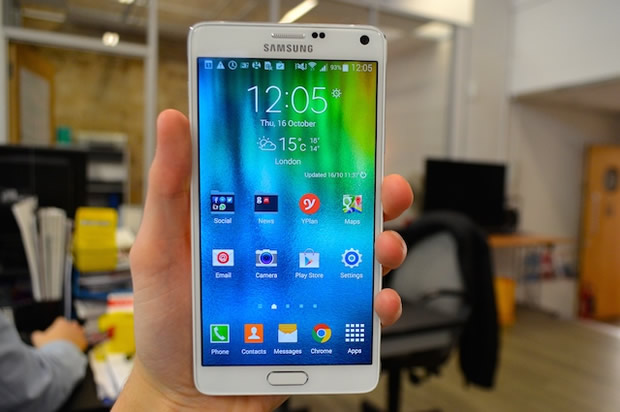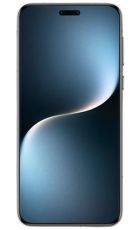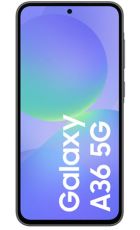
Samsung has come back with the fourth generation of its prize-winning phablet in the shape of the Samsung Galaxy Note 4. The Note 4 has more power under the hood, a more responsive S Pen stylus, a fabulous Quad HD display and a quality metal chassis. Can it still retain the pundits’ adoration, or will Apple’s iPhone 6 Plus sneak away with the glory?
First impressions

Samsung has brought an updated design to the table both with the Note 4 and the Galaxy Alpha. No more chrome-covered plastic here – instead there’s a quality metal body with neatly chamfered edges. It’s a great improvement in terms of design – but then there needs to be some justification of the £629 price.
The body, although metal, is painted white, which is rather too easily scratched on the edges – but it does look good. However, the back of the handset reverts to the faux leather, plastic material of its predecessor. Happily, it has done away with the pretend stitching, but it would be nice to see a softer plastic or indeed the real leather that features on the Motorola Moto X.
The Note 4 measures 8.5mm in width, which goes a great way to masking just how big the chassis is. Weighing in at 176g it feels like a premium product, but is not so heavy that it becomes cumbersome.

The device is also awaterproof – and yet Samsung has managed this without covering the microUSB charging port with a fiddly flap. Another useful feature is the S Pen stylus, which sits in the corner on the bottom right. More about this later.
On-screen
From its spec, the 5.7in display sounds like it should be ahead of all its rivals in terms of quality. It offers a 515ppi and a Quad HD resolution – that’s 1440 x 2550. Better than the iPhone 6 Plus in terms of pixel density and on a level with the top-rate LG G3.
However, that’s not the end of the story – yes, all those pixels ensure that text is smooth and images are really sharp, but you can’t actually squeeze more onto the screen. The iPhone 6 (with its smaller screen) displays exactly the same amount of Facebook updates and Twitter tweets as the Note 4 on its 1in bigger screen.

It seems to negate the whole point of having a higher resolution – but we hope that in future app developers will be creating applications that make the most of the Quad HD display.
AMOLED displays have previously been too bright and artificial looking, but Samsung has now produced a display that is nigh-on perfect. There’s a very faint blue tinge on whites, and the iPhone 6 plus has marginally better viewing angles, but it’s nothing to quibble over.
Performance and software
Previously we have not been fans of the TouchWiz user interface from Samsung. It has felt too cartoon-like and been far too complicated for our liking. However, Samsung started to work on this earlier in the year and now it is far simpler. We did have to switch off the rather annoying noises, and you can still access 21 settings from the pull-down panel, plus there are six full pages of settings to choose from. However, it is far more user friendly and streamlined than it once was.
We’re glad to see the return of S Health, so you can keep track of all your activity, from hiking and cycling to running and walking as well as your sleeping habits, heart rate and so on. A new feature offers an oxygen saturation level monitor, as well as a sensor that can record how harmful the UV rays are. These are situated by the camera flash on the rear of the handset.

Under the hood lurks a powerful 2.7GHz quad-core Snapdragon 805 chip, which is paired up with a good 3GB of RAM to offer great performance. HD video is seamless, games are smooth to play, and apps fire up speedily. It’s just a pity that the home button’s fingerprint scanner isn’t reliable enough – the iPhone 6 beats it on reliability.
You should get a full day out of heavy use out of a full battery, and if you’re not using the phone so much you might stretch to 48 hours. If you get desperate, turn on Ultra Power Saving mode, which will restrict you to emails, texts and calls and turns the display grey. In this mode you should get a whole day out of just 10% of power.
S Pen Stylus

A unique feature of the Note range is the S Pen stylus, which slots in to the right-hand bottom corner. It’s twice as sensitive as the one on the Note 2 and 3 and allows you to find your way around the screen, as well as annotate, draw, take screenshots and notes.
There are also some neat copy and paste features that have been added to the new incarnation, which make it easy to copy text and move it between apps.
The stylus does a clever job of creating something that is more than just a bigger version of a phone (unlike the iPhone 6 Plus).
On camera
Samsung has cut back on software where the snapper is concerned. There are only seven shooting modes on offer – although you can delve deep into menus to find settings to tweak, such as exposure, white balance and ISO.

The snapper has a 16MP sensor, so you get impressive snaps. Want to take a selfie? Just say ‘cheese’ or tap the heart monitor on the rear of the handset. There is also a 3.7MP front-facing snapper, which offers Full HD video and a wide angle lens.
The rear snapper has the facility to grab 4K Quad HD video, along with slow motion at 240fops, ‘smooth motion’, and fast motion.

Low light images impress thanks to optical image stabilisation. It means the sensor can capture more light without resorting to using the flash.
Voice recorder
Another interesting feature is the voice recorder. It uses three microphones so it can judge where the sound is coming from, and it can either mute or isolate it. So if you’re recording a group interview or round table for instance, you can detect and label everyone’s voices – and even mute interruptions so you can clearly hear the other person talking. It’s very clever and will particular appeal to journalists who have to record in loud environments.
Our conclusion
The Samsung Galaxy Note 4 is the best pallet we have seen to date. It shows Samsung understands what consumers are looking for when they consider a larger phone – it’s not all just about a big display, nor is it about taking a phone and just making it bigger.
Samsung has managed to produce an entirely different product with amazing screen resolution and the extra functionality that comes with the S Pen stylus.
If you have already dismissed the stylus as a gimmick, we recommend that you try it for yourself. Not only does it have this great functionality, but the Note 4 looks classy, is well made, offers top performance, a fantastic display, impressive camera, and software that will continue to get better.
A handset this big won’t appeal to everyone, but if it does, this is the one to choose.
Some people may defect to the iPhone 6 plus, but for Android fans the Note 4 offers a far more complete package.






